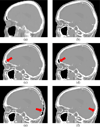Quantitative characterizations of ultrashort echo (UTE) images for supporting air-bone separation in the head
- PMID: 25776205
- PMCID: PMC4405190
- DOI: 10.1088/0031-9155/60/7/2869
Quantitative characterizations of ultrashort echo (UTE) images for supporting air-bone separation in the head
Abstract
Accurate separation of air and bone is critical for creating synthetic CT from MRI to support Radiation Oncology workflow. This study compares two different ultrashort echo-time sequences in the separation of air from bone, and evaluates post-processing methods that correct intensity nonuniformity of images and account for intensity gradients at tissue boundaries to improve this discriminatory power. CT and MRI scans were acquired on 12 patients under an institution review board-approved prospective protocol. The two MRI sequences tested were ultra-short TE imaging using 3D radial acquisition (UTE), and using pointwise encoding time reduction with radial acquisition (PETRA). Gradient nonlinearity correction was applied to both MR image volumes after acquisition. MRI intensity nonuniformity was corrected by vendor-provided normalization methods, and then further corrected using the N4itk algorithm. To overcome the intensity-gradient at air-tissue boundaries, spatial dilations, from 0 to 4 mm, were applied to threshold-defined air regions from MR images. Receiver operating characteristic (ROC) analyses, by comparing predicted (defined by MR images) versus 'true' regions of air and bone (defined by CT images), were performed with and without residual bias field correction and local spatial expansion. The post-processing corrections increased the areas under the ROC curves (AUC) from 0.944 ± 0.012 to 0.976 ± 0.003 for UTE images, and from 0.850 ± 0.022 to 0.887 ± 0.012 for PETRA images, compared to without corrections. When expanding the threshold-defined air volumes, as expected, sensitivity of air identification decreased with an increase in specificity of bone discrimination, but in a non-linear fashion. A 1 mm air mask expansion yielded AUC increases of 1 and 4% for UTE and PETRA images, respectively. UTE images had significantly greater discriminatory power in separating air from bone than PETRA images. Post-processing strategies improved the discriminatory power of air from bone for both UTE and PETRA images, and reduced the difference between the two imaging sequences. Both post-processed UTE and PETRA images demonstrated sufficient power to discriminate air from bone to support synthetic CT generation from MRI data.
Figures











Similar articles
-
Ultrashort echo (UTE) versus pointwise encoding time reduction with radial acquisition (PETRA) sequences at 3 Tesla for knee meniscus: A comparative study.Magn Reson Imaging. 2016 Feb;34(2):75-80. doi: 10.1016/j.mri.2015.09.003. Epub 2015 Oct 3. Magn Reson Imaging. 2016. PMID: 26435460
-
PET attenuation correction using synthetic CT from ultrashort echo-time MR imaging.J Nucl Med. 2014 Dec;55(12):2071-7. doi: 10.2967/jnumed.114.143958. Epub 2014 Nov 20. J Nucl Med. 2014. PMID: 25413135 Free PMC article.
-
MR-based attenuation correction for PET/MRI neurological studies with continuous-valued attenuation coefficients for bone through a conversion from R2* to CT-Hounsfield units.Neuroimage. 2015 May 15;112:160-168. doi: 10.1016/j.neuroimage.2015.03.009. Epub 2015 Mar 14. Neuroimage. 2015. PMID: 25776213 Free PMC article.
-
An Update in Qualitative Imaging of Bone Using Ultrashort Echo Time Magnetic Resonance.Front Endocrinol (Lausanne). 2020 Sep 29;11:555756. doi: 10.3389/fendo.2020.555756. eCollection 2020. Front Endocrinol (Lausanne). 2020. PMID: 33117275 Free PMC article. Review.
-
3D MRI with CT-like bone contrast (3D-BONE): a pictorial review of clinical applications.Acta Radiol. 2025 Feb;66(2):228-240. doi: 10.1177/02841851241300616. Epub 2025 Jan 23. Acta Radiol. 2025. PMID: 39846183 Review.
Cited by
-
Magnetic resonance image guidance in external beam radiation therapy planning and delivery.Jpn J Radiol. 2017 Aug;35(8):417-426. doi: 10.1007/s11604-017-0656-5. Epub 2017 Jun 13. Jpn J Radiol. 2017. PMID: 28612288 Review.
-
Deep Learning for Synthetic CT from Bone MRI in the Head and Neck.AJNR Am J Neuroradiol. 2022 Aug;43(8):1172-1179. doi: 10.3174/ajnr.A7588. AJNR Am J Neuroradiol. 2022. PMID: 36920777 Free PMC article.
-
Evaluating the Hounsfield unit assignment and dose differences between CT-based standard and deep learning-based synthetic CT images for MRI-only radiation therapy of the head and neck.J Appl Clin Med Phys. 2024 Jan;25(1):e14239. doi: 10.1002/acm2.14239. Epub 2023 Dec 21. J Appl Clin Med Phys. 2024. PMID: 38128040 Free PMC article.
-
Pseudo CT Estimation from MRI Using Patch-based Random Forest.Proc SPIE Int Soc Opt Eng. 2017 Feb;10133:101332Q. doi: 10.1117/12.2253936. Proc SPIE Int Soc Opt Eng. 2017. PMID: 31607771 Free PMC article.
-
MRI-only treatment planning: benefits and challenges.Phys Med Biol. 2018 Feb 26;63(5):05TR01. doi: 10.1088/1361-6560/aaaca4. Phys Med Biol. 2018. PMID: 29393071 Free PMC article. Review.
References
-
- Berker Y, et al. MRI-based attenuation correction for hybrid PET/MRI systems: a 4-class tissue segmentation technique using a combined ultrashort-echo-time/Dixon MRI sequence. J Nucl Med. 2012;53:796–804. - PubMed
-
- Chen L, Nguyen TB, Jones E, Chen Z, Luo W, Wang L, Price RA, Jr, Pollack A, Ma CM. Magnetic resonance-based treatment planning for prostate intensity-modulated radiotherapy: creation of digitally reconstructed radiographs. Int J Radiat Oncol Biol Phys. 2007;68:903–911. - PubMed
-
- Dowling JA, Lambert J, Parker J, Salvado O, Fripp J, Capp A, Wratten C, Denham JW, Greer PB. An atlas-based electron density mapping method for magnetic resonance imaging (MRI)-alone treatment planning and adaptive MRI-based prostate radiation therapy. Int J Radiat Oncol Biol Phys. 2012;83:e5–e11. - PubMed
-
- Greer PB, Dowling JA, Lambert JA, Fripp J, Parker J, Denham JW, Wratten C, Capp A, Salvado O. A magnetic resonance imaging-based workflow for planning radiation therapy for prostate cancer. Med J Aust. 2011;194:S24–S27. - PubMed
Publication types
MeSH terms
Grants and funding
LinkOut - more resources
Full Text Sources
Other Literature Sources
Medical
